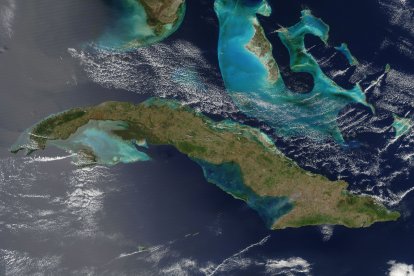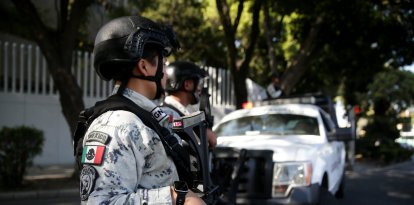The Chinese Threat
A new report with satellite images details China's new spy base in Cuba
The Beijing regime has several radar sites to pick up U.S. signals on the Caribbean island and is investing to improve and increase capabilities.

NASA image taken by MODIS on the Aqua satellite.
China is expanding its spying capabilities on the island of Cuba. A new report from the Center for Strategic and International Studies (CSIS), revealed satellite imagery detailing the growing presence of signals intelligence facilities (SIGINT) that could capture sensitive civilian and military communications and information coming from Florida.
This detailed information, presented in the form of a multi-page interactive report, expands on information that the White House confirmed in 2023. Then, Washington declassified a series of intelligence documents on Chinese bases that have been in Cuba since at least 2019.
The report lists at least four bases that China operates on the island. Some of them are located in places that the United States has already identified, since they were used by the Soviet Union during the Cold War. This is the case with the Bejucal base, which stored Russian nuclear warheads during the 1962 Missile Crisis.
Bejucal is accompanied by the Salao, Wajay and Calabazar bases. Most of them are located in the outskirts of the capital of Havana, with the exception of the Salao base. The latter is located in the region of Santiago de Cuba, closer to the U.S. base at Guantanamo Bay.
This Salao base is the most recent of the four facilities operated by China to carry out SIGINT tasks. According to the report, CSIS analyzed satellite imagery covering 2,900 square kilometers in which it discovered a major new SIGINT collection site under construction just east of the city of Santiago de Cuba, near a neighborhood called El Salao. The structure, whose construction began in 2021, appears to be a large CDAA with a projected diameter of 420 to 650 feet. CDAAs are arrays of antennas arranged in a circular configuration to perform precise signal intelligence gathering tasks.
The CSIS report concludes that once operational, this Salao CDAA will serve as a powerful tool for improving air and maritime domain awareness in the region where the U.S. military and its international partners operate on a regular basis. Apparently, some CDAAs of this approximate size are capable of tracking signals from 3,000 to 8,000 nautical miles away.
The Pentagon remains vigilant
Major General Pat Ryder, stated, "We know that (China) is going to continue to try to enhance its presence in Cuba." He added that "we continue to monitor this closely, taking steps to counter it," he added.
Florida is exposed
Florida is the closest U.S. state to Cuba. In Florida, there are a number of military infrastructures that could be exposed to the spying antennas that China has deployed in Cuba. The NASA space bases that are based in Florida are also exposed, such as the one at Cape Canaveral.
The report assures in this regard, that China has a strong interest in assessing the progress of space rocket launches that SpaceX carries out from Florida. "The study of these launches - especially those of SpaceX's Falcon 9 and Falcon Heavy reusable first-stage rockets - is likely to be of great interest to China, which is trying to catch up with the U.S. lead in space launch technology," CSIS stated.
Cuba denies everything
After CSIS published its report, the Cuban regime issued a statement denying the information. Cuba's Vice Minister of Foreign Affairs Carlos F. de Cossio spoke out on social media after an article was published by the Wall Street Journal that reported on information presented by CSIS.
"Persists Wall Street Journal in launching a campaign of intimidation related to #Cuba. Without citing a verifiable source or showing evidence, it seeks to scare the public with legends about Chinese military bases that do not exist and no one has seen, including one at the U.S. Embassy in Cuba," the deputy minister said. His team added that it is all part of a disinformation campaign.
Clandestine Chinese police stations
These clandestine police stations operate behind the façade of businesses or associations, when in reality they are delegations of the Chinese Ministry of the Interior that serve as coordination points for agents and officials of the communist government. Over the course of previous years, the DOJ and U.S. authorities have gone so far as to dismantle several of these intelligence precincts in New York.
According to the latest reports, there are at least 102 known to exist in 53 different countries, nearly double the amount discovered in September 2022. According to a report by Safeguards Defenders, there are 22 police stations in the Americas. Half of them are in South America: two in Argentina (both in Buenos Aires), three in Brazil (Rio de Janeiro, Sao Paulo and one in an unknown location), one in Chile (Viña del Mar), one in Colombia (Bogota), three in Ecuador (Guayaquil, Quito and one in an unknown location) and Peru (exact location unknown).
The Chinese government strongly denies their existence. In addition to carrying out intelligence tasks, these branches of the Chinese Ministry of the Interior also aim to control Chinese citizens who have left the country. It is also a way to persecute political dissent abroad.
RECOMMENDATION





















